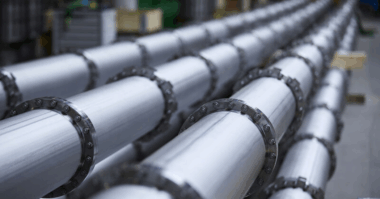As a fast-growing segment of the energy industry, solar is garnering more and more attention, and as this sector grows, the manufacturers involved become more aware of the challenges solar presents. One example of this is the handling of harsh chemicals and slurries used in the production of the solar cells. The precise, exacting processes involved in solar cell manufacture require pumps that are well-suited for both “wet” and “dry” applications. In addition, these pumps need to be able to run dry, handle media with large solids, have a variety of flow-rate and discharge-pressure options, and be compatible with the abrasive and corrosive silicon-carbide slurry that is the fulcrum of the solar cell manufacturing process.
One of the world’s largest providers of silicon-carbide slurry reprocessing within the solar industry is CRS Reprocessing Services in Louisville, Kentucky. In its years as a slurry reprocessor, CRS has had the opportunity to use a number of different types of pumps in its operations, all of which failed to meet its needs. In fact, CRS installed pumps previously that would last only a few hours or days before failing. Finally, in the summer of 2005, CRS found a solution: E-Series plastic air-operated double-diaphragm (AODD) pump technology.
The E-Series pumps from Almatec®, Kamp Linfort, Germany, a member of the Pump Solutions Group (PSG™), are built to withstand the harsh conditions in the production of solar cells. The pumps are ideal for harsh solar cell slurry-handling applications because they are constructed with polyethylene (PE) or PTFE, which has an abrasion resistance seven times higher than polypropylene and 1.6 times higher than steel. The solid-body construction results in a harder, more reliable pump that can easily handle the demands of working with slurry. Additional advantages include increased pump safety, increased product capacity, decreased air consumption, reduced noise level, and optimized flow pattern.
For more on how CRS Reprocessing Services has benefited from the use of Almatec E-Series AODD Pumps in its slurry-reprocessing applications, check out the following items:
- • Case Study: CRS Reprocessing Services (online version)
- • Case Study: CRS Reprocessing Services (PDF version)
- • Video: Almatec success with CRS Reprocessing Services
- • Video: Almatec from the Intersolar North America show
CRS is just one example of many solar successes. The fourth annual of Intersolar North America was recently held in San Francisco, California, USA, and judging by the number of attendees and exhibiting companies, as well as the overall enthusiasm everyone was exhibiting at the show, I think it’s safe to say that the future of solar in North America looks bright. Upwards of 20,000 attendees and more than 800 exhibiting companies were on hand, necessitating an increase of 30% in exhibition space when compared to the 2010 show.
These numbers are in line with recent market analysis that identifies the United States as a leading driving force in the development and use of solar energy. In fact, over the next decade, it is anticipated that the U.S. solar market will more than double and eventually account for more than 10% of global energy demand. Additionally, the June Monthly Energy Review that was released by the U.S. Energy Information Administration (EIA) noted that domestic production of renewable energy — of which solar energy is a major component — for the first time passed domestic production of nuclear power. The EIA also added that energy derived from renewable sources in the U.S. is now 77.15% of that from domestic crude-oil production.
While there’s no doubt solar energy has a growing role in meeting U.S. energy demand, manufacturers of photovoltaic solar cells will have to remain cognizant of the challenges inherent in this harsh manufacturing process. Judging from the success that CRS Reprocessing Services had in using Almatec E-Series pumps (see link above), it’s certain that strategic partnerships that provide solutions to difficult manufacturing challenges will be a key part of realizing success in this growing market.



